Mutton Bone Soup is a spicy soup that is the backbone of South Indian cuisine made with rib bones, pigeon peas, and tomatoes. This delectable soup is dense with nutrients and packed with healing properties. It is one of the best go-to soups for those days when you are under the weather.
If you are ever in a South Indian nonvegetarian eatery, one of the most pervasive dishes is the Mutton Bone Soup. I always thought that it was specific to my home state of Tamil Nadu. I was taken aback when relatives in Southeast Asia and as far afield as the UK would discuss the merits of different versions of this soup. So spread the dish, as did the diaspora. Nowadays, of course, you can get it in many South Indian restaurants globally, especially the Chettinad restaurants. The South Indian Mutton Bone Soup is essentially a bone broth, enhanced with herbs and spices to make it extremely flavorful and highly nutritious. A simple bone broth is made by boiling down meat bones along with the connective tissue.
Benefits of Mutton Bone Soup:
- Bone broth is incredibly rich in minerals such as calcium, magnesium, potassium, and phosphorous, which are important in building and reinforcing your own skeletal structure. The connective tissue contains glucosamine and chondroitin which help support your own cartilage and joint health.
- The marrow in the bone contains vitamin A, vitamin K2, as well as zinc, iron, boron, manganese, and selenium. They also contain both omega-3 and omega-6 fatty acids.
- The gelatin in the bones supports a healthy gut reducing both irritable bowel syndrome, ulcers, and inflammatory bowel disorders.
- The amino acids (glycine and arginine) present in the bone broth can help fight inflammation.
Now, for the South Indian spin. Most Indians know about the humble, staple superfood we call ‘rasam’. Pepper Cumin Rasam is a soup that is prepared using pigeon pea, tamarind pulp, sesame oil, turmeric, cilantro, tomato, peppercorns, garlic, cumin, curry leaves, mustard, coriander seeds, asafetida, salt, and water.
Virtually every South Indian family has its own version, but they all serve the same purpose. It is a digestive, consumed after the meal that helps prevent or help recover from colds and flu. As a digestive, the tamarind (which is rich in fiber) helps smooth bowel movements. The sheer variety of herbs and spices ensures a nutrient-rich and balanced diet. The addition of turmeric and garlic with their antioxidative properties promote general health and speeds metabolism. In fact, a 2018 study by the National Institutes of Health found that a spice-rich diet lowered the risk of heart disease.
I tend to make the Mutton Bone Soup from lamb or mutton bones, preferably the rib bones (which is why sometimes it’s also called the Rib Bone soup), but quite frankly any bones would do. The key thing is to find bones that are rich in the marrow and have also possess connective tissue. What I have found is that this soup, which is sort of a combination of rasam, and the simple bone broth makes this dish spectacular to my friends and family, especially when served as an appetizer.
What I am sharing below is an heirloom recipe handed down over the generations. I have ‘spiced down’ this dish so that it does not carry the heat of what is served in South India, but it possesses sufficient nutrient and flavor profiles. When my kids were growing up, I would serve this dish up at least two to three times a year, just before and after the flu season to maintain their general health.
Difference between coriander and cilantro:
Coriander is the plant seed and cilantro refers to the leaf. While cilantro is beloved by many, there are some who hate it. Specifically, some for whom cilantro tastes soapy. Would it surprise you that this issue is genetic? The variation in a group of olfactory-receptor genes causes them to perceive the soapy-flavored aldehydes that are present in cilantro leaves.
Curry leaves v curry powder:
The curry leaf is a herb. Native to India, the curry leaves are actually a part of the citrus family. Their leaves are glossy green, and they have a very powerful aroma, reminiscent of a lemon leaf that has been crossed with a mint and basil. The citrusy fragrance complements their natural bittersweet taste. While there are many ways to cook curry leaves, they are often fried in oil as a tempering to release their flavor into the dish. The curry powder, on the other hand, is a blend of ground spices such as seeds (coriander, fennel, etc.), cinnamon, cloves, anise, amongst other things. There are several hundred combinations of curry powder, and no two brands taste identical.
Curry leaves are versatile herbs that have antioxidants that protect your body by reducing oxidative stress and reducing free radicals. Curry leaves also help lower cholesterol and triglyceride levels, while also showing some promise of anti-cancer properties. New research shows promise that curry leaves can help remediate neurological diseases such as Alzheimer’s. Like most citrus-based herbs, curry leaves also can also possess antibacterial, antidiabetic, pain-relieving, and anti-inflammatory effects.
Ingredients:
- Pigeon peas (Toor dal): The humble pigeon pea (toor dal) has ancient roots and is an essential and staple part of both the Indian diet and its rich Ayurvedic traditions. This lentil is a rich source of proteins, carbohydrates, and dietary fiber. Its high composition of iron and calcium provides both blood and bone benefits, while the fibrous promotes healthy digestion, supports weight loss, and reduces LDL cholesterol. Additionally, this lentil is chockful of minerals such as magnesium, manganese, phosphorus, potassium, sodium, and zinc which aid in physical and mental well-being. Split pigeon peas can be purchased at any Indian grocery stores.
- Coriander seeds: Studies have shown that coriander may lower blood sugar by activating certain enzymes, which is why people with low blood sugar should use it cautiously. Coriander is rich in antioxidants, such as terpinene, quercetin, and tocopherols, which have demonstrated immune-boosting, cancer remediating, and anti-inflammatory properties. Studies have also demonstrated that coriander may promote heart health by lowering blood pressure and LDL (bad) cholesterol while increasing HDL (good) cholesterol.
- Fennel seeds: Fennel can be sometimes difficult to incorporate into a dish that is NOT a salad. To overcome that, I love to use fennel seeds which provide important nutrients, such as vitamin C, calcium, magnesium, potassium, and manganese. But one of the most interesting aspects of fennel is that they contain polyphenol antioxidants which are powerful anti-inflammatory agents, in addition to having compounds that are anticancer, antimicrobial, and antiviral. Studies have shown that people whose diets are rich in these antioxidants have a reduced risk of heart disease, obesity, cancer, neurological diseases, and type 2 diabetes. Like the coriander, both the leaves and the seeds can be consumed. While there are studies that support the hypothesis that fennel may ease menopausal symptoms, more research needs to be done. Additionally, fennel is a diuretic and so helps treat high blood pressure. While cooked fennel is generally sautéed or roasted, it gives a sweet licorice-like flavor.
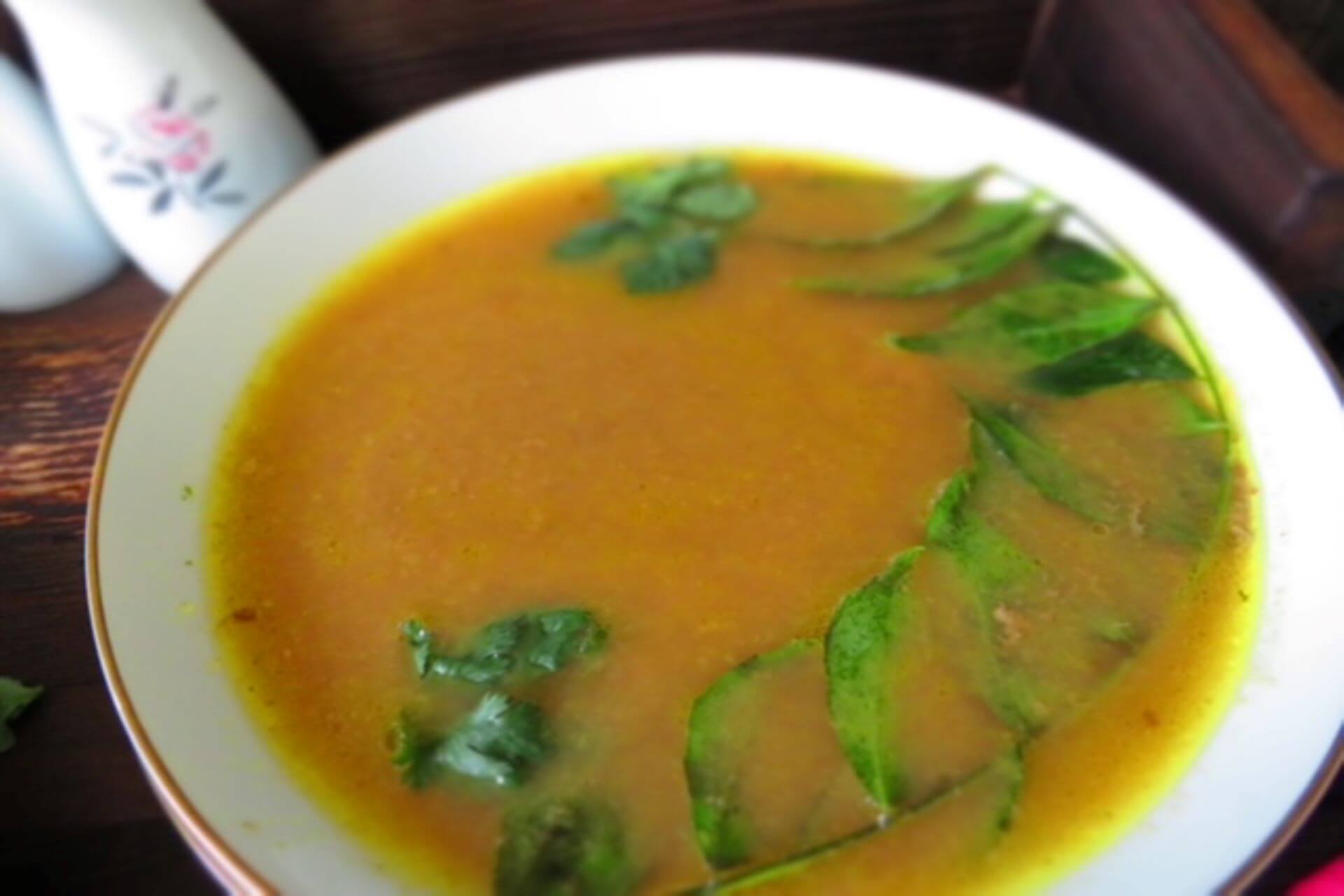
Variations of the Mutton Bone Soup:
This recipe is also known as Elambu soup in Tamil Nadu. The recipe was meant to be made with ribs (markandam) or bones with marrow. I have tried other variations using the following:
- Any part of lamb with bones
- Chicken with bones such as thighs, drumsticks, or wings
What parts to use for this soup:
- Ribs
- Leg bones
- Bones with marrow
- Chop pieces
- Shoulder blade
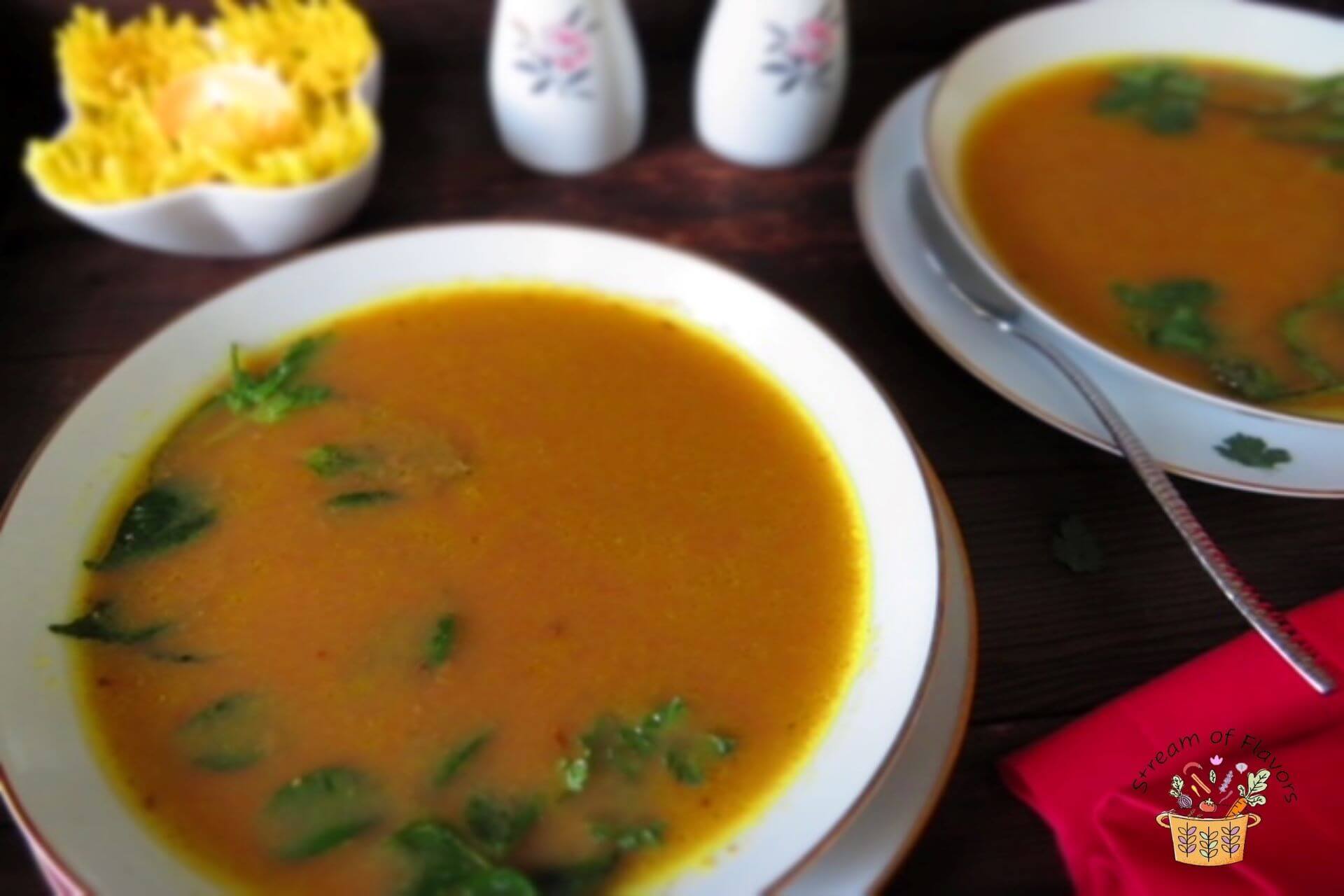
How to make the Mutton Bone Soup:
- How to marinate and precook the mutton:
- How to make the spice paste:
- How to make the Mutton Bone Soup:
- How to marinate and precook the mutton:
- Trim the fat on the mutton bones and ribs and wash thoroughly. Add the marinade ingredients to the mutton and marinate for at least 15 minutes.
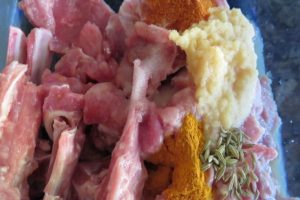
- Pressure cook with 8 cups of water for 4 whistles or 3 lines on the WMF cooker.
2. How to make the spice paste:
- Heat the ghee on medium in a pan and roast the coriander seeds and peppercorns for a minute or until fragrant, taking care not to burn the seeds. Add the soaked toor dhal (without the water), cinnamon, and cloves and roast for a few seconds. Turn off the heat.
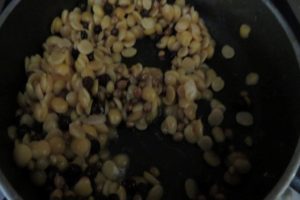
- Grind the spice paste without water and keep aside.
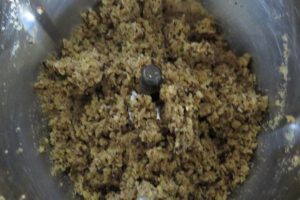
3. How to make the Mutton Bone Soup:
- In the same pan, heat sesame oil and sauté the onion for 2 minutes.
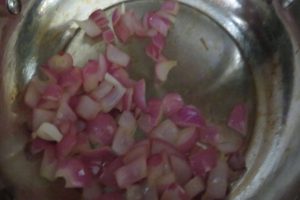
- Then, add the tomatoes and sauté for 2 minutes on medium heat. Add the garlic, ginger and fresh cilantro stalks and sauté for another minute and turn off the heat.
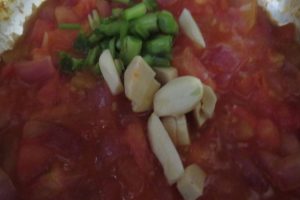
- Add the onion-tomato mixture to the spice paste and grind together.
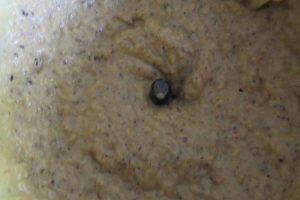
- Open the pressure cooker and turn it on (once the pressure has gone down). Add the spice paste-onion mixture to it and cook for 5 minutes with salt (add a ½ cup of the washed mixer water and the soaked dhal water).
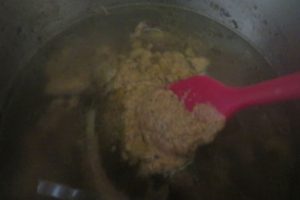
- In a pan, add a teaspoon of sesame oil, heat it and temper with cumin seeds.
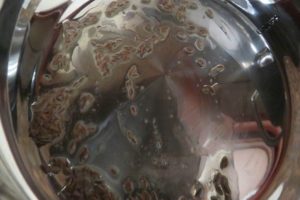
- Add curry leaves and stir for a minute. Add the tempering to the soup.

- Garnish with cilantro leaves. Serve hot with rice or bread.
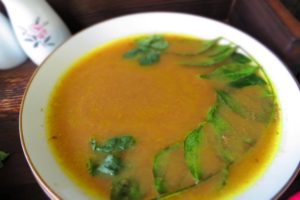
1. Bone-in mutton and/or ribs are perfect for this recipe. Boneless mutton will not taste the same.
2. Trim the fat from the bones but leave the meat and some skin on as it will release flavors during cooking.
Suggestions on how to serve the Mutton Bone Soup:
Mutton Bone Soup is served as a soup in bowls as an appetizer before serving Dum Biriyani or in serving bowls to be mixed with rice. For the dessert course, you could serve the Kesar Pista Kulfi!
How to store:
This Mutton Bone Soup tastes great when it is freshly made. However, you could refrigerate for 2-3 days or freeze in an airtight box for a month.
Mutton Bone Soup
Equipment
- Pressure cooker
Ingredients
For the marinade:
- 1 lb mutton bones ribs, fat rimmed
- 1 tbsp ginger-garlic paste
- ½ tsp red chili powder
- ¼ tsp fennel seeds
- ½ tsp turmeric powder
- ½ tsp salt
For the spice paste:
- ½ tsp clarified butter (ghee)
- 1 tbsp black peppercorns
- 1 tbsp coriander seeds
- 1 tbsp thor dhal (soaked) (yellow split pigeon peas)
- ½ stick cinnamon
- 3 cloves
For the Mutton bone soup:
- 1 tsp sesame oil
- 1 onion sliced
- 2 tomato chopped
- 2 cloves garlic
- 1 tsp ginger
- 5 fresh cilantro stalks
- 1½ tsp salt
- 1 tsp cumin seeds for tempering
- 4 sprigs curry leaves for tempering
- 3 sprigs cilantro for garnish
Instructions
How to marinate and pre-cook the mutton:
- Trim the fat on the mutton bones and ribs and wash thoroughly. Add the marinade ingredients to the mutton and marinate for at least 15 minutes.
- Pressure cook with 8 cups of water for 4 whistles or 3 lines on the WMF cooker.
How to make the spice paste:
- Heat the ghee on medium in a pan and roast the coriander seeds and peppercorns for a minute or until fragrant, taking care not to burn the seeds. Add the soaked thor dhal (without the water ), cinnamon, and cloves and roast for a few seconds. Turn off the heat.
- Grind the spice paste without water and keep aside.
How to make the Mutton Bone Soup:
- In the same pan, heat sesame oil and saute the onion for 2 minutes.
- Then, add the tomatoes and saute for 2 minutes on medium heat. Add the garlic, ginger and fresh cilantro stalks and saute for another minute and turn off the heat.
- Add the onion-tomato mixture to the spice paste and grind together.
- Open the pressure cooker and turn it on (once the pressure has gone down). Add the spice paste-onion mixture to it and cook for 5 minutes with salt (add a ½ cup of the washed mixer water and the soaked dhal water).
- In a pan, add a teaspoon of sesame oil, heat it and temper with cumin seeds.
- Add curry leaves and stir for a minute. Temper the soup with the cumin seeds and curry leaves.
- Garnish with cilantro leaves. Serve hot with rice or bread.
Nutrition


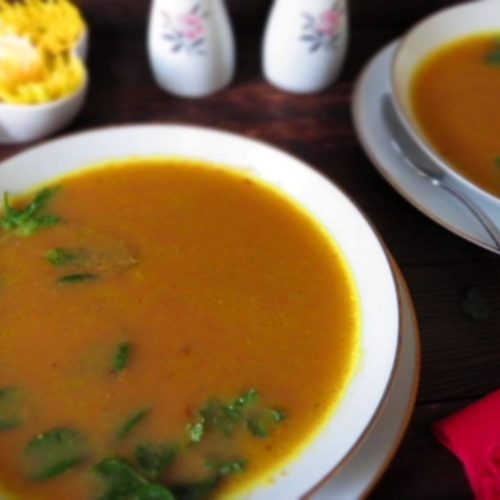





















The recipe tasted so flavorful! Excellent spice paste proportion – highly recommend!
Ishani, I too love this recipe – it has never failed me. Thank you!
Delicious!
Best,
Ram
This recipe is SO close to how my mom used to make it back in India. It’s not like the low meat content and somewhat fatty version that we get Anjappar. I get to make it home now and so I’m thankful to you for publishing it.
That is wonderful, thank you again!